
An Examination of the Narrow Money Supply-Inflation Relationship in the Turkiye Economy Using the AARDL Method
Chapter from the book:
Şahin,
A.
(ed.)
2023.
Academic Research and Evaluations in Social Sciences - V.
Synopsis
The inflation rate, characterized by continuous upward movements in general price levels, constitutes a variable that exerts adverse effects on both the real and financial sectors of the economy. In this context, the success of monetary and fiscal policies developed to ensure price stability will be contingent upon the accurate identification of inflation and its determining factors. In this regard, this study examines the impact of narrow money supply, specifically M1 money supply, and labor-based real effective exchange rate on inflation in the Turkish economy using annual frequency data for the period spanning from 1980 to 2022. The stationarity of the series has been tested using the conventional Augmented Dickey-Fuller (ADF) test, and structural breaks have been examined using the Zivot-Andrews unit root tests, which model potential structural breaks in the data series. Long-term relationships and causal links between the series were investigated using contemporary econometric methods, namely Augmented ARDL (AARDL) and Bootstrap symmetric causality tests. It has been concluded that non-stationary series exhibit a 'true' long-term cointegration relationship among them. The statistically significant, yet relatively insignificant, impact of increases in narrow money supply on inflation has been identified. Additionally, it has been observed that increases in the real effective exchange rate have the anticipated effect of reducing inflation. According to the results of the Bootstrap symmetric causality analysis, it has been concluded that there are bidirectional causality relationships between narrow money supply and inflation. Furthermore, there is no discernible causal relationship between the real effective exchange rate and inflation. Consequently, inferences have been drawn that the inflationary environment in the Turkish economy stems from shocks in the exchange rate and structural factors.

